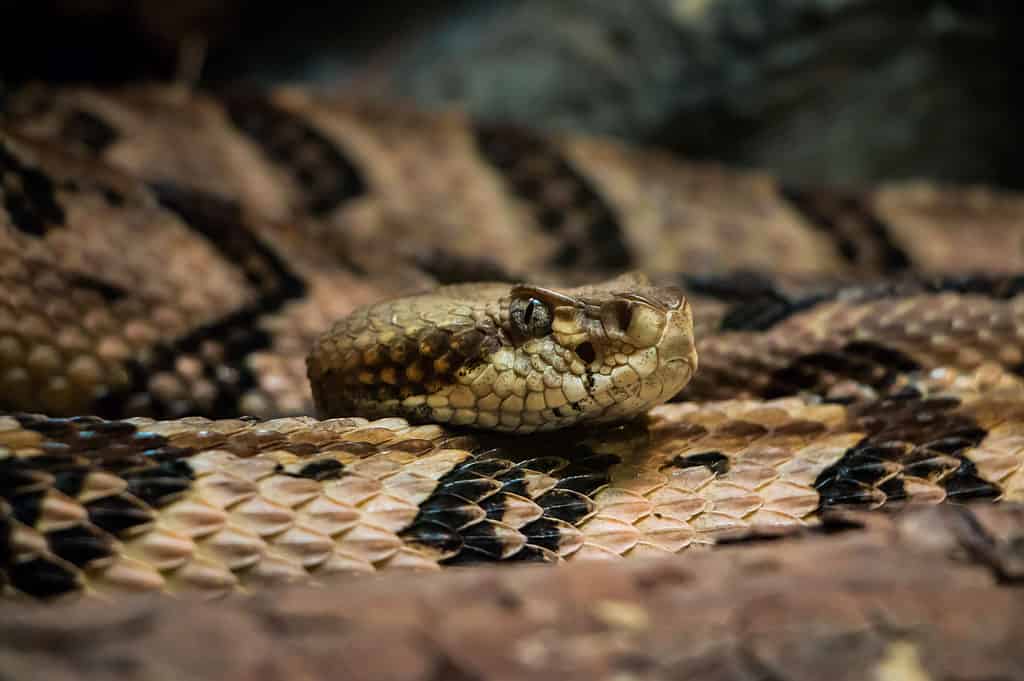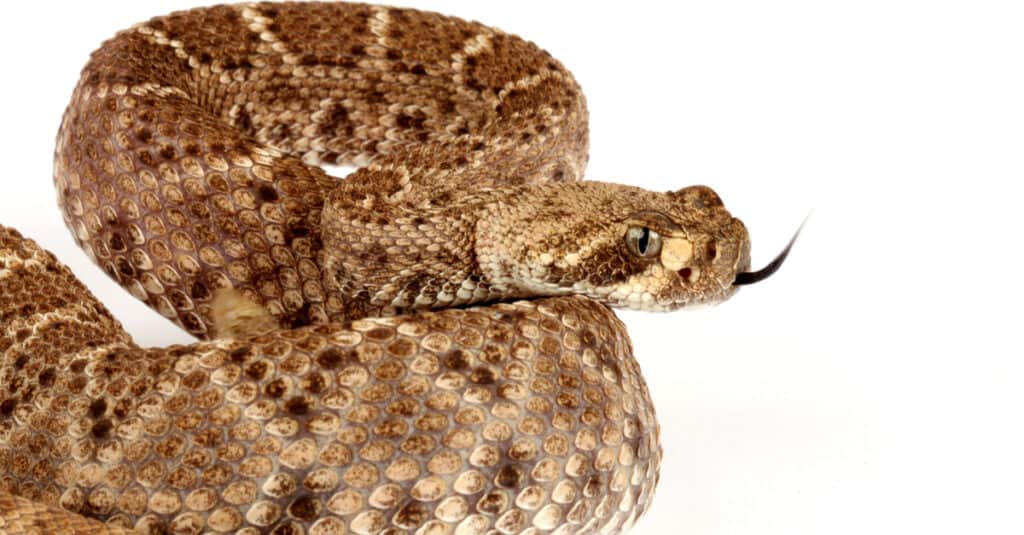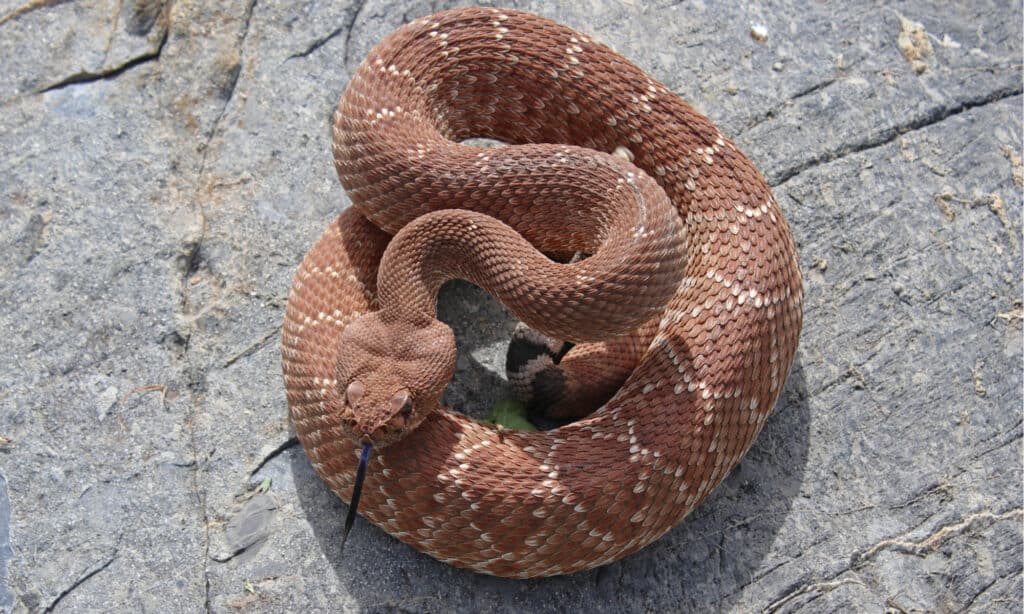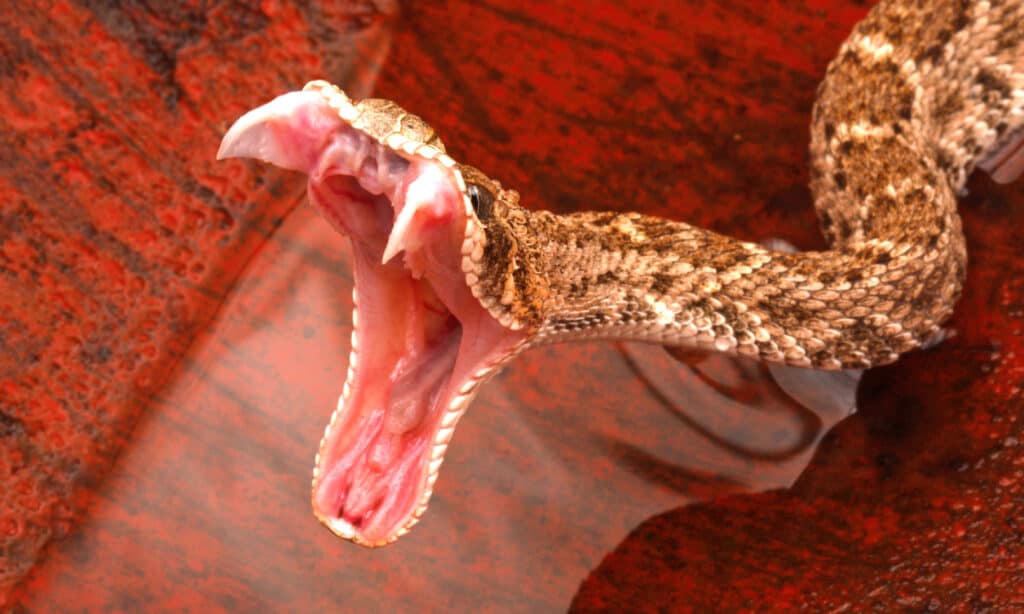Imagine being abandoned on a volcanic rattlesnake-infested island. This nightmarish scenario is exactly what happened to a few scientists recently. Not all rattlesnakes are dangerous, but still, no one wants to be trapped near a gigantic snake nest. Keep reading to discover the snake-infested volcanic island known as “the biggest rattlesnake nest in the world”.
About Rattlesnakes
Venomous rattlesnakes are part of the Viperidae family and are native to the Americas. When they feel threatened, these snakes make rattling noises by shaking the muscles at the base of their tail to scare off predators. Rattlesnakes are the leading contributor to snakebite injuries in North America, though their bite is rarely fatal.
Timber Rattlesnakes

Native to eastern North America, timber rattlesnakes grow between 36 to 60 inches long.
©Dennis Riabchenko/Shutterstock.com
Timber rattlesnakes have a very toxic bite. Native to eastern North America, timber rattlesnakes grow between 36 to 60 inches long. However, sometimes they stop maturing at shorter lengths. For example, the shortest mature female to produce eggs was 28.4 inches long. However, the longest timber rattlesnake recorded was 74.5 inches long! Typically, these rattlesnakes weigh less than 3.3 pounds. However, some timber rattlesnakes reach an impressive 9.9 pounds. You can find these snakes nearly all across America, including Minnesota, Texas, Iowa, and Canada.
Western Diamondback Rattlesnakes

Most of them are a unique dusty-looking gray-brown color with blotches on their bodies in the form of distinct diamond shapes.
©Audrey Snider-Bell/Shutterstock.com
The western diamondback rattlesnake is also known as the Texas diamond-back. Despite its name, this rattlesnake species inhabits many places outside of Texas, including the southwestern United States and Mexico, where it hunts small mammals. Adults usually grow up to 4 feet, but some reach past 5 feet long. Most of them are a unique dusty-looking gray-brown color with stripes in varying shades. They also have blotches on their bodies in the form of distinct diamond shapes. Of all types of rattlesnakes in the United States, this species is responsible for the most bites.
Prairie Rattlesnakes

These snakes have a heat-sensitive pit on each side of their head, which helps them detect temperatures.
©taviphoto/Shutterstock.com
Prairie rattlesnakes are a common species with triangular heads and blotches on their scales. These snakes have a heat-sensitive pit on each side of their head, which helps them detect temperatures. They also have the longest range of any rattlesnake in the United States. You can find them anywhere between Mexico and Canada. They commonly hunt for gophers, prairie dogs, birds, and mice, striking quickly when they are close enough to their prey.
Red Diamond Rattlesnake

Most red diamond rattlesnakes have dorsal scales arranged in 29 rows, but this number varies between 25 to 31.
©Creeping Things/Shutterstock.com
Red diamond rattlesnakes are bright pit vipers with distinctly triangular heads. They are found in southwestern California and Baja California in Mexico. They are large snakes, sometimes exceeding 39 inches long. Most red diamond rattlesnakes have dorsal scales arranged in 29 rows, but this number varies between 25 to 31. Interestingly, coastal red diamond rattlesnakes consume large mammals compared to desert-dwelling red diamond rattlesnakes. Although you should seek treatment if ever bitten by a snake, this species has one of the least potent venoms compared to all species.
What Is The Biggest Rattlesnake Nest In The World?
Tortuga Island is known as “the biggest rattlesnake nest in the world”. This island in the Gulf of California is relatively new, produced by recent volcanic activity. However, its best known for its large native population of Tortuga Island rattlesnakes. Interestingly, this species is only found on this one small island. They grow up to 39 inches long, with the largest recorded at 41.7 inches. They are a grey or greyish brown, sometimes having a slight purple or pink hue. Similar to the red diamond, they have rows of dorsal scales. Although these snakes are listed as least concern, they are limited to Tortuga Island.
This island is popular with scientists, specifically because of its young age and its unique rattlesnake population. Three scientists recently visited the island for a research trip, and they were left stranded for three days. The boatman who dropped them off was supposed to return to take them back to the peninsula, but he never showed up. Instead, the three were rescued by a naval vessel after they were reported missing. Luckily, they were all safe and healthy, and despite all the rattlesnakes, none of the researchers was bitten.
Where Is Tortuga Island Located On A Map?
Tortuga Island is a beautiful Caribbean island that belongs to Haiti. It’s located near the northwest side of Hispaniola. The island is also known as Île de la Tortue in French, Latòti in Haitian Creole, and Isla Tortuga in Spanish, which all mean Turtle Island.
Here is Tortuga Island on a map:
What U.S. Rattlesnake Species Are the Most Dangerous?
Rattlesnakes are among the most deadly venomous snakes in the U.S. But their bites vary in toxicity, so it’s a good idea to be educated on what rattlesnakes are the most dangerous.
Mojave Green Rattlesnake

Some experts classify the Mojave green rattlesnake as the deadliest rattlesnake species in the United States.
©iStock.com/Shoemcfly
Many experts classify the Mojave green rattlesnake, native to the Southwestern U.S. as well as Mexico, as the deadliest rattlesnake species on Earth. Its venom, which can be either hemotoxic or neurotoxic, can cause symptoms like vision impairment, difficulty swallowing and breathing, muscle weakness, severe body pain, convulsions, and death by cardiac arrest or respiratory failure if left untreated.
Eastern Diamondback Rattlesnake

The Eastern diamondback rattlesnake is responsible for the most deaths in the U.S. from snake bites.
©Chase D’animulls/Shutterstock.com
This rattler, found in the Eastern United States, is another contender for the deadliest rattlesnake in the United States. It’s also one of the largest snakes in the U.S., growing to a max length of 8.5 feet and max weight of 34 pounds. Its bite contains hemotoxic venom, capable of killing red blood cells and causing tissue damage. Another problem lies in the fact it can deliver 400-700 mg of venom in its bite, compared to 200-300 mg in the western diamondback rattlesnake, so its venom can lead to death. It’s believed that the Eastern diamondback rattlesnake is responsible for the most deaths by snakebite in the U.S.
Western Diamondback Rattlesnake

The venom from a Western diamondback rattlesnake is hemotoxic, attacking red blood cells and causing tissue damage to bite victims.
©iStock.com/johnaudrey
Close on the heels of the Eastern variety is the Western diamondback rattlesnake, native to the U.S. Southwest and northern Mexico. Its venom is hemotoxic, killing cells and tissue, causing blood clotting (or preventing clotting) that can result in massive internal bleeding, and causing possible cardiovascular failure. Some experts think this type of rattlesnake actually outranks the Eastern diamondback in terms of overall deaths to humans.
Other deadly U.S. rattlesnake species include:
- Timber Rattlesnake
- Massasauga Rattlesnake
- Southern Pacific Rattlesnake
- Banded Rock Rattlesnake
- Desert Massasauga Rattlesnake
The photo featured at the top of this post is © Dario Sabljak/Shutterstock.com
Discover the "Monster" Snake 5X Bigger than an Anaconda
Every day A-Z Animals sends out some of the most incredible facts in the world from our free newsletter. Want to discover the 10 most beautiful snakes in the world, a "snake island" where you're never more than 3 feet from danger, or a "monster" snake 5X larger than an anaconda? Then sign up right now and you'll start receiving our daily newsletter absolutely free.
Thank you for reading! Have some feedback for us? Contact the AZ Animals editorial team.






